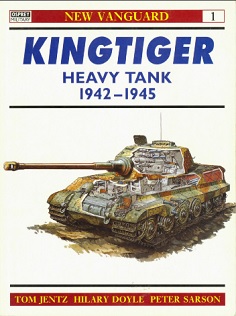
Kingtiger Heavy Tank 1942-1945
Tom Jentz & Hilary Doyle
48 pages
published in 1993
Osprey is one of the largest publishers of war nerd and wargaming nerd books in the world, publishing books since 1969. They pulbish roughly a dozen series, each focusing on a specific range of military subject; the New Vanguard series in which this was published is about military equipment and vehicles, but not airplanes. Kingtiger Heavy Tank 1942-1945 was the first book published in it and set the tone for the series.
The focus here is on the machine, not so much on how it was used, so there are a lot of pages about the development of the Tiger II, chronicling the minor and major differences between subvariants. Lots of details about armour thickness and gun lengths and calibres and such. Of course there’s only limited room for this in a 48 page book, much of which is also taken up by the drawings and pictures that are the main attraction, but Tom Jentz and Hilary Doyle are both very thorough writers. It’s only at page 36 that we get to the operational history of the tank.
But of course the main draw, pun intended, of these books is the artwork, in the very capable hands of Peter Sarson. Every New Vanguard book is build around the cut away illustration on the middle pages, but I personally like the three view diagrams on the preceding and following pages better. Sarson gives a good impression of the sheer mass and brute strength of the Tiger II. these are big tanks and they look it.
Much of what’s in this book is only of interest to real war nerds; the emphasis is solely on the machine, not on how it was used let alone the goals it was used for. Jentz and Doyle do a good job of making the design and production history of the Tiger II understandable. They hit the usual notes of the complicated prehistory of the design, with two competing turrets, the Porsche and Henschel, the latter ultimately winning, as well as the teething problems that the relatively quick introduction of the tank caused. They go on to describe in detail the various production variants, followed by the unit history. In the end you have a good overview of the Tiger II’s history, though it’s still only an introduction. A small library has been written about the Tiger II after all.